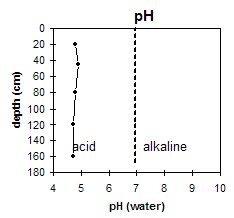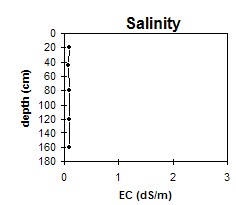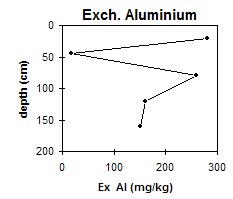CFTT3
| SITE: CFTT 3 | Site: Mt Worth East |
| Location: APP species/seedlot trial VRV 145 | Aust. Soil Class.: Acidic, Mesotrophic, Brown DERMOSOL |
| Great Soil Group: brown podsolic | Tech. Class: 051-5-50/4-1-1-32 |
| Site Description: Waning lower 5% slope to south-west | Geology: Cretaceous sediments |
| APP Mapping Unit: Balook | |
Soil Profile Morphology:
Surface Soil
| A1 | 0 – 20 cm | Dark greyish brown (10YR4/2); clay loam; moderate medium polyhedral structure; very weak consistence moist; pH 4.8; gradual and smooth transition to: | |
| Subsoil | |||
| B21 | 20 - 40 cm | Brown (10YR5/3); clay loam; moderate coarse polyhedral structure; weak consistence moist; pH 4.9; diffuse and smooth transition to: | |
| B22 | 40 – 80 cm | Greyish brown (10YR5/2), with few, fine, faint yellowish brown (10YR5/6) mottles; light clay; weak coarse polyhedral structure; weak consistence moist; pH 4.8; diffuse and smooth transition to: | |
| B23 | 80 – 120 cm | Grey (10YR5/1), with common, medium, distinct yellowish brown (10YR5/4) mottles, medium clay; weak coarse polyhedral structure; firm consistence moist; pH 4.7; gradual transition to: | |
| B24 | 120 – 160 cm | Grey (10YR5/1), with many, medium, distinct yellowish brown (10YR5/4 and 10YR5/6) mottles; medium clay; weak very coarse to coarse polyhedral structure; firm consistence moist; pH 4.7. | |
Key Profile Features:
- Lack of strong texture contrast between surface (A) horizon and subsoil (B) horizons.
pH | Salinity Rating | |||
Surface (A1 horizon) | Very strongly acid | Very low | Non-sodic | none |
Subsoil (B21 horizon) | Very strongly acid | Very low | Non-sodic | none |
Deeper subsoil (at 1.2 m) | Very strongly acid | Very low | Non-sodic | none |
 The soil profile is very strongly acid throughout |  The salinity rating is very low throughout the profile. |  The level of exchangeable aluminium is high throughout most of the strongly acid soil profile (apart from the upper subsoil). |  The clay percentage increases gradually with depth down the soil profile. |
Horizon | Horizon Depth | pH (water) | pH CaCl2 | EC 1:5 | NaCl | Exchangeable Cations | |||
Ca | Mg | K | Na | ||||||
Meq/100g | |||||||||
A1 | 0-20 | 4.8 | 4.2 | 0.09 | 2.4 | 1.7 | 0.55 | 0.19 | |
B21 | 20-45 | 4.9 | 4.2 | 0.07 | 1.6 | 1.4 | 0.38 | 0.17 | |
B22 | 45-80 | 4.8 | 4.1 | 0.09 | 1.7 | 2.2 | 0.5 | 0.19 | |
B23 | 80-120 | 4.7 | 4 | 0.09 | 2 | 4.8 | 0.54 | 0.27 | |
B24 | 120-160 | 4.7 | 3.9 | 0.09 | 2.1 | 5.1 | 0.61 | 0.28 | |
Horizon | Horizon Depth | Ex Al mg/kg | Ex Ac meq/100g | Field pF 2.5 | Wilting Point pF4.2 g/100g | Coarse Sand (0.2-2.0mm) % | Fine Sand (0.02-0.2mm) % | Silt (0.002-0.02mm) % | Clay (<0.002mm) % |
A1 | 0-20 | 280 | 16 | 40 | 18.1 | 1.5 | 23.9 | 35.5 | 34.5 |
B21 | 20-45 | 18 | 16 | 36.8 | 14.9 | 1 | 25.4 | 38.5 | 32.5 |
B22 | 45-80 | 260 | 16 | 37.2 | 18.2 | 0.6 | 21.7 | 33 | 43.5 |
B23 | 80-120 | 160 | 24 | 44.3 | 24.2 | 0.1 | 12.5 | 21.5 | 61.5 |
B24 | 120-160 | 150 | 26 | 49.4 | 7.4 | 0.2 | 9.4 | 21 | 66 |
Management Considerations:
- Levels of exchangeable Potassium (K) relative to the other basic cations (ie. Na, Ca, Mg) are quite high (although not as high as for site CFTT1).
- The high levels of exchangeable aluminium in much of the very strongly acid soil profile may restrict the growth of aluminium sensitive species.
- The very strongly acid soil profile indicates that some trace elements (eg. copper, molybdenum) may be poorly available to plants.
- The clayey surface soil is liable to compaction from heavy trafficking or overstocking when in a moist to wet condition.
- The upper metre of the soil profile has a weak consistence when moist – indicating that root movement should not be significantly restricted.


